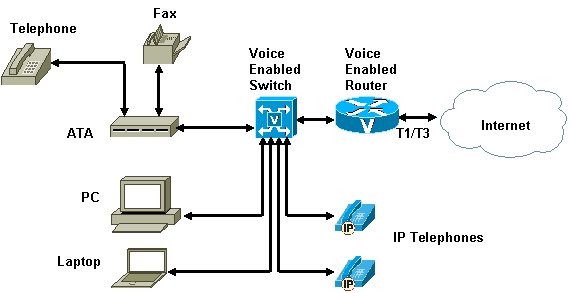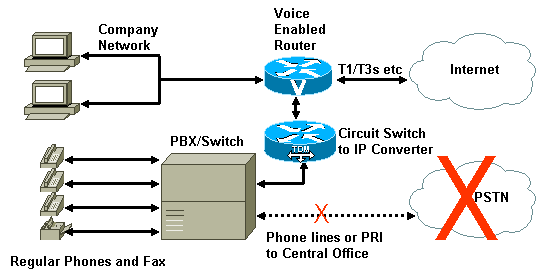Business VoIP Solution
For small to medium sized businesses with between 5 and 100 employees, it is generally more cost effective to select a Business VoIP service provider that is dedicated to this particular market. This is one of the fastest growing areas for Business VoIP and is expected to account for more than 1.7 million lines and $1 billion in market size in 2007 according to Forrester Research. For this particular Business VoIP market, the VoIP service provider typically installs a voice enabled router that connects to a T1 or T3 line depending on your telephony and data requirements. This can support all of your voice and data needs for your company and provides a Quality of Service (QoS) such that your voice packets get higher priority than your data packets during high traffic times. A large switch connects the router to your Local Area Network (LAN) and any IP based device can then be connected to the switch whether it be a computer, an IP phone, or just an ATA and a regular analog telephone. One possible Business VoIP solution for small to medium sized businesses is highlighted in the following diagram. Note that additional phone lines and PCs can be added simply by connecting them to the large voice enabled switch. This type of configuration is often referred to as a hosted VoIP, hosted PBX, virtual PBX or IP PBX phone system (see notes below for further information). All of the technology for handling your calls resides in the VoIP service providers network, so any type of adds, moves or changes can be done easily by you through a web browser and a secure login website. This removes the cost of hiring someone to do this. The features for these plans are extensive. If you need to add an employee, the system is very flexible. Simply add another business VoIP seat (i.e. another phone line) with your web browser, connect your phone to the LAN and you are up and running. No more expensive and time consuming installations to add a telephone line. Likewise, if you cannot make it into your office say due to bad weather simply stay at home, use your own internet broadband connection to login to the secure website for your hosted VoIP PBX and forward your work calls to your home or cell phone. Note that sometimes a SMB will keep a certain number of regular phone lines or Primary Rate Interfaces (PRI) that connect to the Public Switched Telephone Network (PSTN) for backup purposes. If you lose power to your building and you do not have some form of backup for your power, you will lose all communication to the outside world. This is one of the main reasons a SMB may consider keeping one or two traditional telephone lines. We touched on the term Hosted PBX above since this is the most common VoIP service used by small to medium sized businesses. Let's expand on this further. A hosted VoIP PBX is basically an IP-based management service located at your VoIP service providers network operations center. The functions associated with a hosted PBX service are similar to those of hardware PBX systems installed at your business site. The main difference is that your company is not responsible for buying, installing, or maintaining any of the PBX equipment. It is all maintained and upgraded by the service provider thus saving your business significant money in terms of capital expenditure and of course administration costs since you do not need to pay an IT person to maintain your own PBX. What are some of the advantages of a hosted PBX (Virtual PBX)? It is scalable so your business can expand or contract at any time. The PBX is configurable so you can easily add users and modify features through a secure internet site. The equipment is usually made by high caliber companies like Cisco Systems and is therefore very reliable It has many productivity enhancing features such as the ability to listen to voicemails from a PC, call forwarding, individual fax numbers for each user and many more. The Business VoIP provider plans for small offices and home offices tend to be very similar to the residential VoIP service plans and have similar features. Most VoIP residential providers have one or two business VoIP solutions at a relatively small premium to their respective residential VoIP plans. Extra services are often included such as a toll free number and a dedicated fax line. These plans tend to be cost effective for businesses with less than 5 employees. The Business VoIP providers give you the same hardware you would get for a residential VoIP plan, this being the Analog Telephone Adapter (ATA). This is responsible for converting the analog signals from a regular telephone into a format acceptable for transmission over the internet. The ATA normally handles up to 2 telephone lines but if a fax service is required one of the ports is typically needed for the fax machine since it needs its own dedicated number and phone line. A typical home office or small business VoIP solution is highlighted in the following diagram. Note that additional phone lines and PCs can be added simply by connecting them to the LAN side of the router. For small office environments these plans tend to work well and additional phone lines can be purchased at the same monthly rate. However, eventually this expansion will no longer be possible since each phone line requires up to 90 kbits/s of your Broadband bandwidth before even considering your data needs. Note that this depends on the codec selected for voice compression. For a standard small office Broadband Internet connection (e.g. cable or DSL) this tends to set the maximum limit to about 5 employees and that is with the assumption that not all employees are making a VoIP call at the same time. For businesses with more than 5 employees it is recommended that you sign up for a VoIP Small to Medium sized Business (SMB) plan as described above. For this market segment, a large business is considered to be one that has greater than 100 employees. Previosuly there has not been too much demand from large companies to move to a business VoIP solutions. This is because they have usually already paid a substantial amount of money for their PBX and they have the misconception that they would need to throw away their PBX in order to move to VoIP. However this is not the case and there are many Business VoIP plans that actually make use of the circuit switched PBX as well as those catering to businesses that need a new digital PBX - often referred to as an on-premise IP PBX. The Business VoIP service provider adds equipment that converts the circuit switched outputs from the PBX into IP packets and then passes them to a Voice Enabled Router that also handles the company data network. All of the IP packets, voice and data, are then routed to the internet often via T1 or T3 lines. The company may then remove the expensive phone lines or the Primary Rate Interface (PRI) that previously were sent to the PSTN. Typically, large businesses can save over 30% in their monthly telephony costs after switching to a business VoIP solution. One possible Business VoIP solution for a larger sized business that already has a PBX is highlighted in the following diagram. The PSTN and telephone lines or PRI can be removed from the system since all of the data and voice now travel over the internet. However, in practice, a reduced number of standard circuit switched phone lines tend to remain connected to the PSTN purely for backup purposes. If you have a large business and interested in quotes for an on-premise IP PBX phone system, consult our on-premise IP PBX section. For companies that have their own on-premise VoIP solution often SIP trunking is of interest. Visit our SIP Trunking Provider comparison page to find the best provider for your needs.Business VoIP Solution for the Small to Medium sized Business (SMB)

Hosted PBX (also referred to as Hosted VoIP or Virtual PBX)
Business VoIP Solution for the Small Office and Home Office (SOHO)

Business VoIP Solution for the Large Business

